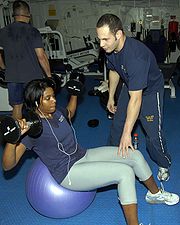
Swiss ball
Encyclopedia

Elastomer
An elastomer is a polymer with the property of viscoelasticity , generally having notably low Young's modulus and high yield strain compared with other materials. The term, which is derived from elastic polymer, is often used interchangeably with the term rubber, although the latter is preferred...
with a diameter
Diameter
In geometry, a diameter of a circle is any straight line segment that passes through the center of the circle and whose endpoints are on the circle. The diameters are the longest chords of the circle...
of approximately 35 to 85 centimeters (14 to 34 inches) and filled with air. The air pressure is changed by removing a valve stem
Valve stem
A valve stem is a self-contained valve which opens to admit gas to a chamber , and is then automatically closed and kept sealed by the pressure in the chamber, or a spring, or both, to prevent the gas from escaping...
and either filling with air or letting the ball deflate. It is most often used in physical therapy
Physical therapy
Physical therapy , often abbreviated PT, is a health care profession. Physical therapy is concerned with identifying and maximizing quality of life and movement potential within the spheres of promotion, prevention, diagnosis, treatment/intervention,and rehabilitation...
, athletic training and exercise.
It can also be used for weight training.
The ball, while often referred to as a Swiss ball, is also known by a number of different names, including balance ball, birth ball, body ball, ball, fitness ball, gym ball, gymnastic ball, physioball, pilates ball, Pezzi ball, sports ball, stability ball, Swedish ball, therapy ball, or yoga ball.
History
The physical object known as a "Swiss Ball" was developed in 1963 by Aquilino Casani, an Italian plastics manufacturer. He perfected a process for molding large puncture-resistant plastic balls. Those balls, then known as "Pezzi balls", were first used in treatment programs for newborns and infants by Mary Quinton, a British physiotherapist working in Switzerland. Later, Dr. Susanne Klein-Vogelbach, the director at the Physical Therapy School in Basel, Switzerland, integrated the use of ball exercise as physical therapy for neuro-developmental treatment. Based on the concept of "functional kinetics", Klein-Vogelbach advocated the use of ball techniques to treat adults with orthopedic or medical problems. The term "Swiss Ball" was used when American physical therapists began to use those techniques in North America after witnessing their benefits in Switzerland. From their development as physical therapy in a clinical setting, those exercises are now used in athletic training, as part of a general fitness routine and incorporation in alternative exercises such as yoga and PilatesPilates
Pilates is a physical fitness system developed in the early 20th century by Joseph Pilates in Germany, the UK and the USA. As of 2005, there were 11 million people practicing the discipline regularly and 14,000 instructors in the United States....
.
Benefits

Muscle
Muscle is a contractile tissue of animals and is derived from the mesodermal layer of embryonic germ cells. Muscle cells contain contractile filaments that move past each other and change the size of the cell. They are classified as skeletal, cardiac, or smooth muscles. Their function is to...
s. Those muscles become stronger over time to keep balance. Most frequently, the core body muscles — the abdominal muscles and back muscles — are the focus of exercise ball fitness
Physical fitness
Physical fitness comprises two related concepts: general fitness , and specific fitness...
programs.
Other uses
Some people recommend sitting on an exercise ball instead of a chair (for example, an office chair). This is based on the theory that the abdominal and back muscles are constantly engaged and active in order to maintain proper posture and balance on the ball. There is no scientific evidence of those benefits occurring by just sitting without additional exercises. However, some people warn against using a Swiss ball as a chair due to ergonomic considerations or biomechanical reasonsThis large plastic ball, known as a "birth ball", can also be used during labour to aid the descent of the fetal head into the pelvis. Sitting in an upright position will also aid fetal positioning and is more comfortable for the woman. Sitting on the ball with arms placed on a bed, table or otherwise sturdy object for support and gently rocking the hips may help the woman during contractions and aid the natural physiological process of birth.

